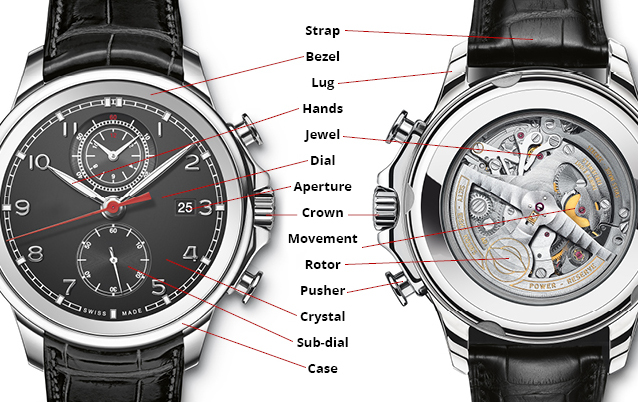The watch diagram below outlines the basic elements in fine watches to build a basic understanding of their technical makeup.
A strip or band of leather or rubber that holds the watch to the wrist. It must be non-metal to be considered a strap; a metal version is a bracelet.
Usually made of metal, the bezel is a ring around the crystal on the top portion of a watch that holds the glass or crystal in place.
Sometimes referred to as horns, lugs are projections on the watch case that are used to secure the strap or bracelet to the watch case.
Indicators that move over the dial to point at the hour, minute or second. Watches generally have three hands to show the hours, minutes and seconds.
Small Sapphires or Rubies, located on the movement, that reduce friction by acting as bearings for gears in a mechanical watch.
A plate, with a metal base and visible through a crystal, that carries certain indication, such as the hours, minutes and sometimes seconds.
A small opening (also called a “window”) in the dial that displays certain information such as the date, day, month or moon-phase.
A button on the outside of the watch case used to set the time and calendar. On mechanical watches, it is also used to wind the mainspring.
Acting like an engine, a movement is the inner mechanism of a watch that keeps time and powers the watch’s functions. (For more info: please see Types of Watches below)
Attached to the watch movement, the rotor rotates freely to wind the mainspring and store power in automatic timepieces.
Button(s) located outside of the case that control specific functions of the watch. Pushers are most commonly found on watches with a chronograph.
Made of glass, plastic or synthetic Sapphire, the crystal is a transparent cover that protects the watch dial and reduces glare.
A small dial placed inside the main dial on a watch’s dial that give information not provided by the main watch dial such as a chronograph.
The container that protects the watch movement. Cases are available in many shapes such as round, square, oval, tonneau and rectangular.
Types of Watches
A watch movement (also known as a “calibre”) is the engine of a watch that acts as the powerhouse to make the watch and its functions work. This internal mechanism inside the timepiece moves the hands and powers any complications such as a chronograph, annual calendar or a dual time zone. Driving all of the timekeeping functions, the movement is the essential component in a watch and keeping accurate time; a watch would not function without it. There are countless different movements that are created by watch manufactures utilizing proprietary innovations, but each of these movements will fall into one of two categories—quartz or mechanical. An easy way to differentiate a quartz from a mechanical movement is by looking at the second hand. On a quartz watch, the second hand has the tick-tick motion that moves once per second while mechanical watches have a smooth, sweeping seconds motion.
- Quartz movements are very accurate and require minimal maintenance aside from battery replacements. They tend to be low cost since they are battery powered and have few moving parts. Quartz watches aren’t as desirable to most watch enthusiasts because they lack the technical craftsmanship and engineering that mechanical timepieces have. Quartz movements in fine Swiss watch brands, such as Patek Philippe, are designed to comply with their strict quality standards. How a Quartz Movement Works: A quartz movement utilizes a battery as its primary power source and is typically the type of movement that you will find in your standard, no frills watch. To create power in quartz watch movements, a battery sends an electrical current through a small quartz crystal, electrifying the crystal to create vibrations. These vibrations keep the movement oscillating and drive the motor to move the watch hands.
- Mechanical movements are often chosen over quartz movements for luxury watches because of the level of quality and craftsmanship of mechanical movements. Skillfully created by expert watchmakers, these movements contain an intricate series of tiny components working together to power the timepiece. Although the general design of mechanical watches hasn’t changed much in centuries, technology has allowed for more precise engineering and a greater attention-to-detail. How a Mechanical Movement Works: Unlike quartz movements, a mechanical movement uses energy from a wound spring (mainspring), rather than a battery, to power the watch. This spring stores energy and transfers it through a series of gears and springs, regulating the release of energy to power the watch.
Watch Complications
A watch complication is any function that exists in addition to telling time (displaying hours, minutes and seconds) on a timepiece. These watch complications enable special functions that are performed and displayed on the watch to enhance or simplify your life. The more complications that exist in a watch make it more difficult to design and create because a number of additional elements must be built into the standard movement. Several complications are available in timepieces today, from simple date displays to complex functions such as a tourbillon or repeater. These watches are highly sought after because of an appreciation for the genius innovation in design, as well as the complexity, precision and skill required to create such a timepiece. Recent advances in technology have spawned watches with GPS capabilities and that can sync with your Bluetooth phone, but when you remove the back of the case, you aren’t amazed by its battery or computer chip. This is the difference with complicated timepieces. When you view the movement of a complicated watch through its case-back, you’ll see technical innovation and precise engineering. The combination of several hundred tiny gears, jewels and springs enables the timepiece to complete incredible functions; functions that are assembled by hand and not completed by a computer chip.
